Khao Sok National Park
Khao Sok National Park (Thai: เขาสก, pronounced [kʰǎw sòk]) is in Surat Thani Province, Thailand. Its area is 739 km2 (285 sq mi), and it includes the 165 km2 (64 sq mi) Cheow Lan Lake contained by the Ratchaprapha Dam. The park is the largest area of virgin forest in southern Thailand and is a remnant of rain forest which is older and more diverse than the Amazon rain forest.
| Khao Sok National Park | |
|---|---|
IUCN category II (national park) | |
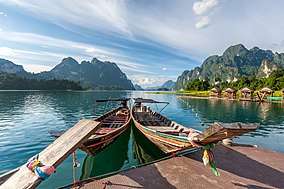 | |
 Map of Thailand | |
| Location | Surat Thani Province, Thailand |
| Nearest city | Surat Thani |
| Coordinates | 8°56′12″N 98°31′49″E |
| Area | 739 km2 (285 sq mi) |
| Established | 22 Dec 1980 |


Geography
Beautiful sandstone and mudstone rocks rise about 300–600 m (984–1,969 ft) above sea level. The park is traversed by a limestone mountain range from north to south with a high point of 950 m (3,117 ft). This mountain range is hit by monsoon rain coming from both the Gulf of Thailand and the Andaman Sea, which makes it among Thailand's wettest regions with an annual rain fall of 3,500 mm (137.8 in). Heavy rainfall and falling leaves led to the erosion of the limestone rocks and created the significant karst formations seen today.
Flora
Bamboo holds topsoil very tenaciously, preventing soil erosion on hillsides and riverbanks. With more than 1,500 species, bamboo is the oldest grass in the world, dating back nearly 60 million years. Liana trees grow rapidly wrapping around any vertical or horizontal support base such as takian or "rain trees". Thus, it's dangerous to simply cut a tree in the jungle because it can pull connected liana vines with it creating a cascade of damage. Buttress roots are enlarged root bases mostly of trees that grow above the upper canopy. The theory about these roots is that they either developed in order to be more grounded in storms and rain or that they spread out on the ground in order to get more nutrients.
Many kinds of wild fruit can be found around the national park and serve as sustenance for animals. Among those fruits are wild jackfruit, mangosteen, durian, rambutan, jujube, pomelo, and wild bananas. Wild pepper and ginger are not uncommon. Khao Sok National Park is perhaps most famous for the bua phut (Rafflesia kerrii) flower.
Wildlife
The park is estimated to contain over five percent of the world's species. Wild mammals include Malayan tapir, Asian elephant, tiger, sambar deer, bear, gaur, banteng, serow, wild boar, pig-tailed macaque, langur, white handed gibbons, squirrel, muntjak, mouse deer, barking deer.
The world's only known amphibious centipede, Scolopendra cataracta, was discovered on a stream bank near the national park in 2001.[1]
Climate
The so-called wet season is between late April–December. The temperature ranges from 22–36 °C (72–97 °F) all year around. Humidity and warm temperature provide the optimal environment for a rich eco-system in this tropical rain forest.
| Jan | Feb | Mar | Apr | May | Jun | Jul | Aug | Sep | Oct | Nov | Dec | |
|---|---|---|---|---|---|---|---|---|---|---|---|---|
| Max. Day Temp., °C | 30 | 32 | 33 | 33 | 31 | 30 | 30 | 30 | 30 | 29 | 29 | 29 |
| Min. Day Temp., °C | 20 | 20 | 21 | 22 | 23 | 22 | 22 | 22 | 22 | 22 | 21 | 21 |
| Water Temp., °C | 27 | 28 | 28 | 29 | 29 | 29 | 28 | 28 | 28 | 28 | 28 | 27 |
| Daylight, hours | 12 | 12 | 12 | 12 | 13 | 13 | 13 | 12 | 12 | 12 | 12 | 12 |
| Rainfall, mm | 41 | 33 | 62 | 148 | 320 | 373 | 372 | 369 | 447 | 332 | 210 | 89 |
Natural History
This area is estimated to be over 160 million years old, built through tectonic movements, climate changes, erosions and sediment accumulations. Approximately 300 million years ago, shallow water and warm temperatures in this region led to the creation of a huge coral reef. Estimated to be 5 times as big as the Great Barrier Reef in Australia, it originally stretched from China all the way to Borneo. Due to the collision of the Indian and Eurasian plate 0-66 million years ago, the Himalayas were formed, and what is now Thailand shifted dramatically near the continental divide and the limestone rocks were forced upward creating the dramatic limestone "karsts" for which the region is known today. Finally, melting ice established the river-rich landscape as well as dozens of waterfalls around the national park.
Human History
The first migrants to Thailand migrated during the Ice Age from Borneo around 37000 BCE. The first accounts of people living in Khao Sok were found in the 1800s. In 1944, the inhabitants of this region were stricken by a deadly epidemic. A large number of the villagers died while the few survivors escaped from the area to settle in nearby Takua Pa.
In 1961, Route 401 was built from Phun Pin in Surat Thani Province to Takua Pa in Phang Nga Province. At the turn of the millennium, they began the process of expanding Route 401 to a 4 lane freeway.
In the 1970s, Thai student activists and communist insurgents set up strongholds in the caves of Khao Sok. Settled in the shelter of the rainforest they protected the region from the Thai army, loggers, miners, and hunters for seven years.
Khao Sok became a national park in 1980. The government and the Electricity Generating Authority of Thailand (EGAT) were interested in this region because Khao Sok holds the largest watershed in southern Thailand.
Only 2 years later, EGAT completed the 94 m (308 ft) high Ratchaprapha Dam, blocking off the Klong Saeng River, a tributary of the Phum Duang River and creating a 165 km2 (64 sq mi) lake inside the park. The dam provides electricity for the south, and the lake became a major holiday destination for Thai and foreign tourists alike. There were several species of animals that had to be resettled to save them from drowning, as the lake slowly filled over a period of 3 years. Unfortunately, a study from 1995 revealed the loss of some 52 species of fish from the river, which could not survive in the stagnant water.
Activities
Khao Sok National Park[2] has various activities for tourists who like adventure such as trekking, canoeing, bamboo rafting or a boat tour to Cheow Lan lake.
Trekking: Due to Khao Sok being a tropical rainforest, there are many wild animals such as “wild elephants, serow, tigers, Malayan sun bears and over 180 bird species to watch”. If you are interested trekking you can hire a local guide. If you are lucky, you will find Rafflesia Kerrii Meijer,[3] and visit waterfalls. Moreover, you can stay in the forest at night and cook with bamboo.
Canoeing and Bamboo rafting: Sok River is a perfect place to relax yourself. You will enjoy beautiful views along the river. Most commonly seen animals for example are birds and fish. Moreover, the view of limestone cliffs, mountain range and wide sky are amazing. They have local guides for you to hire for canoeing and bamboo rafting.
Boat to Cheow Lan lake: After trekking into the deep forest, there are many caves to explore such as Diamond cave, Khang Cow Cave and Nam Talu cave which connect to Cheow Lan lake. Nam Talu cave is about 12 km (7.5 mi)[4] from the headquarters of Khao Sok National Park. If you a buy trip they will have staff waiting for you and boat you from the waterfall to the lake. These are activities that are suitable for adventurers. Khao Sok is not only a relaxing place but also exciting.
Gallery
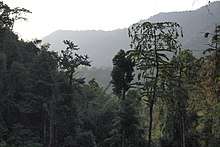 Khao Sok tropical rainforest.
Khao Sok tropical rainforest.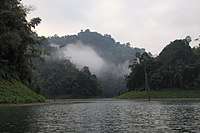 Early morning on Cheow Lan Lake.
Early morning on Cheow Lan Lake.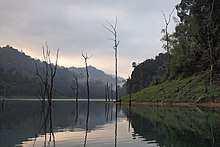 Early morning on Cheow Lan Lake.
Early morning on Cheow Lan Lake.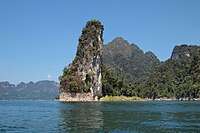 Karst formations on Cheow Lan Lake.
Karst formations on Cheow Lan Lake.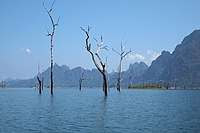 Trees rising out of Cheow Lan Lake.
Trees rising out of Cheow Lan Lake.
References
- Khao Sok National Park official webpage
- Electricity Generating Authority of Thailand (EGAT)
- Waterfalls and Gibbon Calls; Exploring Khao Sok National Park, Thom Henley, 4th Ed, 2011, Phuket Thailand
External links
| Wikimedia Commons has media related to Khao Sok National Park. |

- The Climate of Thailand
- Birdwatching Khao Sok